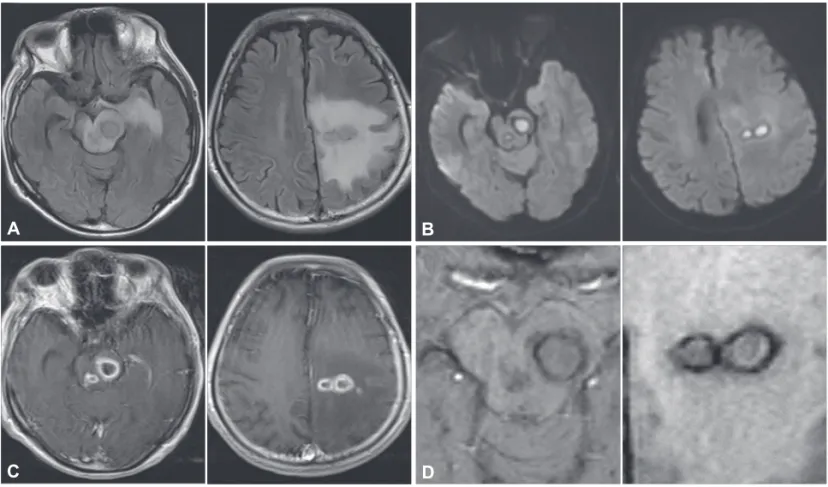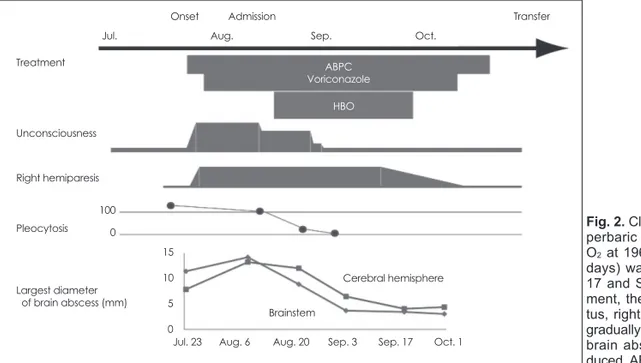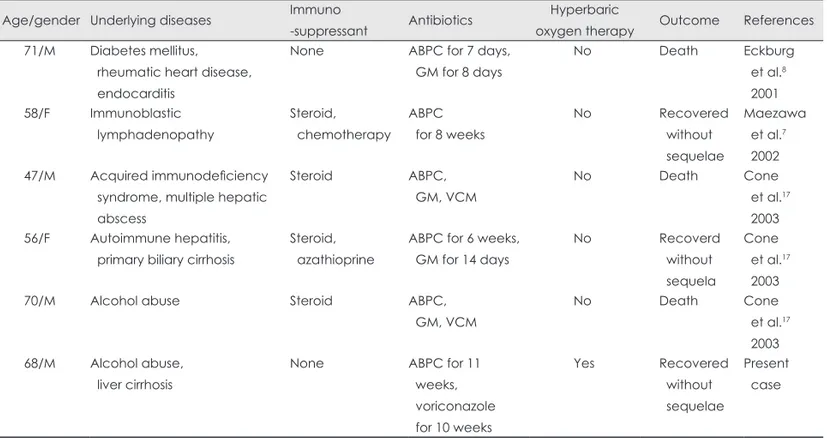http://dx.doi.org/10.3988/jcn.2014.10.4.358 J Clin Neurol 2014;10(4):358-362
Introduction
Listeria monocytogenes (L. monocytogenes) is a facultative anaerobic, Gram-positive bacillus that is commonly isolated from the soil, vegetables, and wild or domestic animals. L.
monocytogenes has a special tropism for the central nervous system (CNS). Meningoencephalitis is the most common CNS manifestation of listerial infection, whereas brain abscess is rare, representing 1–10% of all CNS listerioses.1 Listerial brain abscess is often found in immunocompromised patients with an underlying illness or who are undergoing immuno- suppressive therapy.
Listerial brain abscess has a high mortality and requires ex- tensive treatment with antibiotics, drainage if necessary, and a reduction in immunosuppressives. It can be supra- and subten- torial; while a review of patients with supratentorial listerial abscesses revealed that the survival rate was higher among those provided with surgical drainage,2 the standard therapy for patients with subtentorial lesions has not yet been estab- lished. We report herein a patient with supra- and subtentorial brain abscesses due to L. monocytogenes infection who was treated with combined antibiotics and hyperbaric oxygen (HBO) therapy instead of surgical drainage.
Case Report
A 68-year-old male noticed headaches on July 8, 2012, and then right hemiparesis on July 19 of the same year. The prima- ry care physician diagnosed stroke, and he was admitted to
Drastic Therapy for Listerial Brain Abscess Involving Combined Hyperbaric Oxygen Therapy and Antimicrobial Agents
Keiichi Nakahara,a Satoshi Yamashita,a Katsumasa Ideo,a Seigo Shindo,a Tomohiro Suga,a Akihiko Ueda,a Shoji Honda,a Tomoo Hirahara,a Masaki Watanabe,a Taro Yamashita,a Yasushi Maeda,a Yasuhiro Yonemochi,b Tomohiro Takita,b Yukio Andoa
aDepartment of Neurology, Graduate School of Medical Sciences, Kumamoto University, Kumamoto, Japan
bDepartment of Neurology, National Hospital Organization, Kumamoto Medical Center, Kumamoto, Japan
Received June 15, 2013 Revised September 21, 2013 Accepted September 23, 2013 Correspondence Satoshi Yamashita, MD, PhD Department of Neurology, Graduate School of Medical Sciences, Kumamoto University, 1-1-1 Honjo, Chuo-ku, Kumamoto 860-8556, Japan Tel +81-96-373-5893 Fax +81-96-373-5895
E-mail y-stsh@kumamoto-u.ac.jp
BackgroundzzListeria monocytogenes (L. monocytogenes) is a rare causative pathogen of brain abscess that is often found in immunocompromised patients. Although patients with su- pratentorial listerial abscesses showed a longer survival with surgical drainage, the standard therapy for patients with subtentorial lesions has not been established.
Case ReportzzWe report herein a patient with supra- and subtentorial brain abscesses caused by L. monocytogenes infection. These abscesses did not respond to antibiotics, and his symp- toms gradually worsened. Drainage was not indicated for subtentorial lesions, and the patient was additionally treated with hyperbaric oxygen therapy, which dramatically reduced the vol- ume of abscesses and improved the symptoms.
ConclusionszzThis is the first report of drastic therapy for a patient with listerial brain ab- scesses involving combined antibiotics and hyperbaric oxygen therapy. The findings suggest that hyperbaric oxygen therapy is a good option for treating patients with deep-seated listerial abscesses and for who surgical drainage is not indicated. J Clin Neurol 2014;10(4):358-362 Key Wordszz brain abscess, Listeria monocytogenes, subtentorial lesions, surgical drainage,
hyperbaric oxygen therapy, antimicrobial agents.
Open Access
cc This is an Open Access article distributed under the terms of the Cre- ative Commons Attribution Non-Commercial License (http://creative- commons.org/licenses/by-nc/3.0) which permits unrestricted non-com- mercial use, distribution, and reproduction in any medium, provided the ori- ginal work is properly cited.
hospital. He had no medical history of head trauma, sinusitis, or diabetes, but he drank 1,800 mL of a distilled spirit (equiva- lent to 330 g of ethanol) with blue cheese every day, and had alcoholic liver cirrhosis (Child-Pugh grade B). He was febrile (39.0ºC) and had become progressively paralyzed on the right side of his body. Brain magnetic resonance imaging (MRI) disclosed several ring-enhancing lesions in the brainstem and cerebral hemispheres. A cerebrospinal fluid (CSF) examina- tion revealed pleocytosis, and a blood examination revealed an increased titer of Aspergillus antigen without inflammatory re- action; the (1→3)-β-D-glucan test was negative.
Bacterial cultures taken from two independent vessels grew L. monocytogenes, which led to a diagnosis of multiple brain abscesses due to L. monocytogenes infection. He was treated with ampicillin (ABPC; 2 g every 4 h i.v.) and voriconazole (200 mg/day), but he developed consciousness disturbance and complete right-sided hemiparesis. Follow-up brain MRI disclosed extended lesions, and the patient was transferred to our hospital. Upon admission he had a body temperature of 36.9ºC, and a physical examination revealed neither superfi- cial lymphadenopathy nor hepatosplenomegaly. A neurologic examination revealed that he was in a comatose state (score on the Japan Coma Scale of 30–200). Right blepharoptosis and anisocoria (3.0 mm on the right and 4.0 mm on the left) was
observed. The left light reflex was attenuated, while that on the right was preserved. His oculocephalic reflex was positive.
The right hemiparesis was severe but without muscular waste and fasciculation. The tendon reflexes were exaggerated in the right upper and lower limbs, but without pathologic reflexes.
Neither neck stiffness nor Kernig’s sign was detected. Labora- tory data revealed no inflammatory reaction such as leukocy- tosis or elevation of C-reactive protein, but pleocytosis was evident in the CSF: 101 cells/mm3 (96.6% monomorphonucle- ar and 3.4% polymorphonuclear cells); protein, 201 mg/dL; and glucose, 58 mg/dL (plasma glucose, 78 mg/dL). No pathogen- ic bacteria grew in bacterial cultures of the CSF, blood, urine, and a nasopharyngeal swab.
Brain MRI disclosed several ring-enhancing lesions on the left cerebral hemisphere and brainstem (Fig. 1A and B). High- intensity signals were present inside the mass lesions in diffu- sion-weighted imaging (Fig. 1C). Susceptibility-weighted im- aging disclosed a dual rim sign, defined as two concentric rims at the lesion margins, with the outer rim being hypointense and the inner rim hyperintense relative to the cavity contents (Fig.
1D). MR spectroscopy revealed no elevation of choline in the lesions. Positron-emission tomography (PET) demonstrated no uptake of 2-[fluorine-18]-fluoro-2-deoxy-D-glucose, suggesting the absence of malignancy.
Fig. 1. Brain magnetic resonance imaging on admission. A: Fluid-attenuated inversion-recovery images disclosed iso- to hypointensity le- sions in the midbrain and left cerebral hemisphere with surrounding edema. B: T1-weighted images with gadolinium enhancement showed ring enhancement in these lesions. C: High-intensity signals were present inside in the lesions in diffusion-weighted imaging. D: Suscepti- bility-weighted imaging revealed a dual rim sign: defined as two concentric rims at the lesion margins, with the outer rim being hypointense and the inner rim hyperintense relative to the cavity contents.
A
C
B
D
Treatment with ABPC (2 g every 4 h i.v.) and voriconazole (100 mg every 12 h i.v.) was continued. Diagnostic and thera- peutic drainage for brainstem lesions is not favored at our neu- rosurgical department, and so the patient instead underwent HBO therapy (100% O2 at 196.1 kPa abs at 1 h/day, for 25 days) from August 17. After the treatment, his consciousness status and pleocytosis gradually improved. The anisocoria had resolved by August 20, and voluntary movements of the right upper and lower limbs were possible by September 5 (Fig. 2).
Since the lesions were dramatically ameliorated on follow-up MRI, we terminated the voriconazole and ABPC therapy on October 3 and 10, respectively. The patient was transferred to another hospital for rehabilitation on October 17.
Discussion
We have reported herein a patient with supra- and subtentorial brain abscesses caused by L. monocytogenes infection who was treated concurrently with antibiotics and HBO therapy, resulting in reduction of the volume of the abscesses and im- provement of clinical symptoms. The diagnosis of multiple brain abscesses due to L. monocytogenes infection was reached for the following reasons:
1) The patient presented a remittent fever with at a maxi- mum temperature of 39ºC.
2) Brain MRI at admission disclosed ring-enhancing le- sions in the supra- and subtentorial regions, and SWI revealed a homogeneous dual rim sign, suggesting the presence of brain abscess.3
3) L. monocytogenes, which tends to form abscesses in the brainstem region, grew in blood bacterial cultures performed at first admission.
4) PET revealed no malignancy in the lesions.
While the blood examination disclosed an increased titer of Aspergillus antigen, the spread of Aspergillus species in the CNS generally takes place via the sinuses and is observed pri- marily in the frontal and temporal lobes.4 Furthermore, the negative (1→3)-β-D-glucan test suggested that the brain ab- scesses in this patient were not related to Aspergillus infection, which is usually associated with a high frequency of positivity for this test.
Listeria enters the human host via the intestines after the in- gestion of contaminated food, and spreads to distant tissues via the lymph and blood, using mononuclear phagocytes to disseminate throughout the host from its sites of entry.5,6 L.
monocytogenes is found most frequently in soft cheeses such as blue cheese and infection is usually found in immunocom- promised patients such as pregnant women, infants, and ba- bies. However, this patient consumed large amounts of both blue cheese and alcohol, and we therefore believe that he de- veloped listerial brain abscesses. Listerial brain abscess has a high mortality rate, estimated to be approximately 40%.7 Of note, CSF cultures tested positive in 25% of cases, while blood cultures are usually only positive on repeated cultures.8 Ab- scesses in deep locations such as the thalamus, pons, and me- dulla oblongata are considered pathognomonic for listerial brain abscess because L. monocytogenes spreads via the blood circulation rather than by direct invasion.2
The clinical practice guidelines of the Infectious Diseases Society of America recommend the use of ABPC plus genta- micin as a first-line treatment for L. monocytogenes infection.9 This recommendation was based on the synergistic increase in the bactericidal activity observed in vitro with a combination of ABPC and gentamicin.10 In contrast, a recent study revealed
Fig. 2. Clinical course of the patient. Hy- perbaric oxygen therapy (HBO; 100%
O2 at 196.1 kPa abs at 1 h/day for 25 days) was performed between August 17 and September 20. After the treat- ment, the patient’s consciousness sta- tus, right hemiparesis, and pleocytosis gradually improved. The diameter of the brain abscesses was dramatically re- duced. ABPC: ampicillin.
Treatment
Onset Transfer
Unconsciousness Right hemiparesis
Pleocytosis
Largest diameter of brain abscess (mm)
Admission
ABPC Voriconazole
HBO
Cerebral hemisphere Brainstem
Jul. Aug. Sep. Oct.
Jul. 23 Aug. 6 Aug. 20 Sep. 3 Sep. 17 Oct. 1 15
10 5 0 100
0
that the use of combination therapy increased not only the as- sociated renal toxicity but also the mortality in listeriosis.11 No randomized clinical trial has compared amoxicillin or ABPC alone versus amoxicillin or ABPC plus gentamicin in cases with listerial brain abscess; we therefore did not choose these combination therapies.
While a review of patients with supratentorial listerial ab- scesses revealed that the survival rate was higher among pa- tients provided with surgical drainage,8 the standard therapy for patients with subtentorial lesions has not yet been estab- lished. There are a few case reports of successful stereotactic biopsy and drainage in patients with listerial brainstem ab- scess, resulting in a reduction in the lesion size, identification of the pathogen, and survival.12 As mentioned above, listerial brain abscesses are typically infections of deeper brain struc- tures such as the thalamus, pons, and medulla, where other bacteria rarely cause abscesses.8 It is therefore mandatory to establish a standard therapy for listerial brainstem abscess that does not involve surgical drainage.
The treatment of intracranial abscesses with HBO was first introduced in the 1980s.13,14 There are several possible mecha- nisms by which HBO therapy could have ameliorated the brain abscesses in the present case. First, the production of re- active oxygen species by HBO may have activated the neutro- phils and damaged any aerobic and facultative anaerobic bac- teria, such as L. monocytogenes. Second, HBO therapy may have increased the cerebral arterial oxygen pressure, reduced the intracranial pressure by inducing the contraction of blood
vessels, and thus protected the patient against secondary brain injury. Finally, although L. monocytogenes is a facultative an- aerobic bacterium, which is thought to be natively resistant to HBO,15 we assume that concurrent therapy with HBO and an- timicrobial agents was responsible for the good prognosis in the present case.
There are some factors that need to be considered when ap- plying HBO therapy to patients with brain abscess. First, pa- tients are required to maintain a resting position during the treatment. Second, unconscious patients tend to suffer from middle ear barotraumas due to the pressure inside the middle ear not being equalized with the external pressure.16 We re- solved this problem by applying tympanostomy with sedation before the treatment.
A summary of cases of patients with listerial abscesses who were treated by medication alone and their clinical outcomes are described in Table 1. Three of the five patients died, while the other two survived without sequelae (in addition to the present case), who were treated with concurrent therapy with HBO and antimicrobial agents. Lampl et al.13 postulated that HBO should be considered with the following patient criteria:
multiple brain abscesses, abscess in a deep or dominant loca- tion, early-stage abscess without a need for surgical interven- tion, poor patient condition, and anaerobic or miscellaneous findings from abscess material.
This is the first report of drastic therapy for a patient with listerial brain abscesses who was treated with combined anti- biotic and HBO therapy. The findings suggest that HBO thera-
Table 1. Review of case reports of treatments without surgical drainage in the literature Age/gender Underlying diseases Immuno
-suppressant Antibiotics Hyperbaric
oxygen therapy Outcome References 71/M Diabetes mellitus,
rheumatic heart disease, endocarditis
None ABPC for 7 days, GM for 8 days
No Death Eckburg
et al.8 2001 58/F Immunoblastic
lymphadenopathy
Steroid, chemotherapy
ABPC for 8 weeks
No Recovered
without sequelae
Maezawa et al.7 2002 47/M Acquired immunodeficiency
syndrome, multiple hepatic abscess
Steroid ABPC,
GM, VCM
No Death Cone
et al.17 2003 56/F Autoimmune hepatitis,
primary biliary cirrhosis
Steroid, azathioprine
ABPC for 6 weeks, GM for 14 days
No Recoverd
without sequela
Cone et al.17 2003
70/M Alcohol abuse Steroid ABPC,
GM, VCM
No Death Cone
et al.17 2003 68/M Alcohol abuse,
liver cirrhosis
None ABPC for 11
weeks, voriconazole for 10 weeks
Yes Recovered
without sequelae
Present case
ABPC: ampicillin, GM: gentamicin, VCM: vancomycin.
py is a good option for patients with deep-seated listerial ab- scesses who are not indicated for surgical drainage.
Conflicts of Interest
The authors have no financial conflicts of interest.
REFERENCES
1. Lorber B. Listeriosis. Clin Infect Dis 1997;24:1-9; quiz 10-11.
2. Clauss HE, Lorber B. Central nervous system infection with Listeria monocytogenes. Curr Infect Dis Rep 2008;10:300-306.
3. Toh CH, Wei KC, Chang CN, Hsu PW, Wong HF, Ng SH, et al. Dif- ferentiation of pyogenic brain abscesses from necrotic glioblastomas with use of susceptibility-weighted imaging. AJNR Am J Neuroradiol 2012;33:1534-1538.
4. Sav H, Atalay MA, Demir G, Akif Ozdemir M, Nedret Koc A. Early diagnosis of cerebral aspergillosis with various methods: a case re- port. Infez Med 2013;21:134-138.
5. Dalton CB, Austin CC, Sobel J, Hayes PS, Bibb WF, Graves LM, et al. An outbreak of gastroenteritis and fever due to Listeria monocyto- genes in milk. N Engl J Med 1997;336:100-105.
6. Drevets DA. Dissemination of Listeria monocytogenes by infected phagocytes. Infect Immun 1999;67:3512-3517.
7. Maezawa Y, Hirasawa A, Abe T, Kawamura H, Sekiguchi K, Kuni- moto M, et al. Successful treatment of listerial brain abscess: a case report and literature review. Intern Med 2002;41:1073-1078.
8. Eckburg PB, Montoya JG, Vosti KL. Brain abscess due to Listeria monocytogenes: five cases and a review of the literature. Medicine (Baltimore) 2001;80:223-235.
9. Tunkel AR, Glaser CA, Bloch KC, Sejvar JJ, Marra CM, Roos KL, et al. The management of encephalitis: clinical practice guidelines by the Infectious Diseases Society of America. Clin Infect Dis 2008;47:
303-327.
10. Harwick HJ, Kalmanson GM, Guze LB. In vitro activity of ampicil- lin or vancomycin combined with gentamicin or streptomycin against enterococci. Antimicrob Agents Chemother 1973;4:383-387.
11. van de Beek D, Brouwer MC, Thwaites GE, Tunkel AR. Advances in treatment of bacterial meningitis. Lancet 2012;380:1693-1702.
12. Beynon C, Neumann JO, Bösel J, Unterberg AW, Kiening KL. Ste- reotactic biopsy and drainage of a brainstem abscess caused by Liste- ria monocytogenes. Neurol Med Chir (Tokyo) 2013;53:263-265.
13. Lampl LA, Frey G, Dietze T, Trauschel M. Hyperbaric oxygen in in- tracranial abscesses. J Hyperbaric Med 1989;4:111-126.
14. Kutlay M, Colak A, Yildiz S, Demircan N, Akin ON. Stereotactic as- piration and antibiotic treatment combined with hyperbaric oxygen therapy in the management of bacterial brain abscesses. Neurosur- gery 2005;57:1140-1146; discussion 1140-1146.
15. Vannini L, Lanciotti R, Baldi D, Guerzoni ME. Interactions between high pressure homogenization and antimicrobial activity of lysozyme and lactoperoxidase. Int J Food Microbiol 2004;94:123-135.
16. Kurschel S, Mohia A, Weigl V, Eder HG. Hyperbaric oxygen therapy for the treatment of brain abscess in children. Childs Nerv Syst 2006;
22:38-42.
17. Cone LA, Leung MM, Byrd RG, Annunziata GM, Lam RY, Herman BK. Multiple cerebral abscesses because of Listeria monocytogenes:
three case reports and a literature review of supratentorial listerial brain abscess(es). Surg Neurol 2003;59:320-328.


